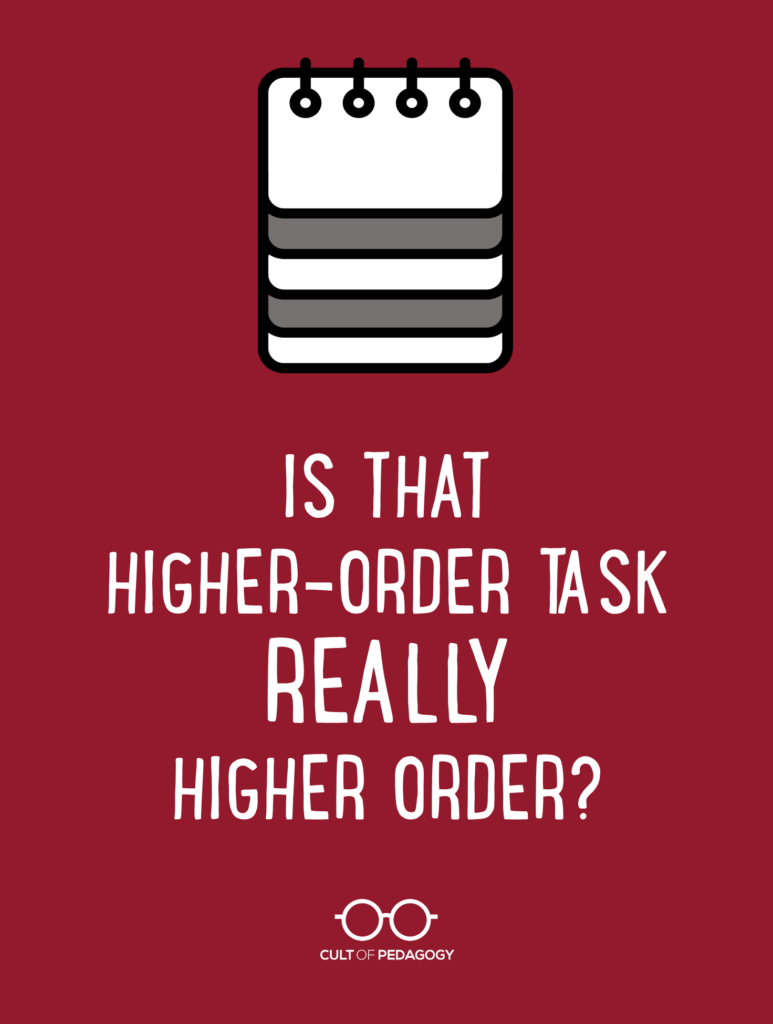
Listen to this post as a podcast:
Sponsored by Chill Expeditions and Kiddom
This post contains Amazon Affiliate links. When you make a purchase through these links, Cult of Pedagogy gets a small percentage of the sale at no extra cost to you.
The mobiles hang from the ceiling like jewelry, filling Ms. Jackson’s language arts classroom with bright, twirling colors. They make a pretty canopy over the room, and if you look closer at the individual dangly bits on each mobile, you’ll see that they contain words: Alliteration, says one, and below it hang four more pieces of paper that give examples of alliteration. Personification, says another. Simile. Metaphor. Onomatopoeia. They’re figurative language mobiles. Ms. Jackson’s students spent two full class periods working on them, and many even took theirs home to finish them before they were put up for display.
When she wrote those two days into her lesson plans, Ms. Jackson thought she was adding higher-order thinking to her students’ learning. After all, they were creating something, weren’t they?
Well, yes and no. Yes, they created mobiles with wire hangers, construction paper, markers, and glue. But they didn’t actually create anything with figurative language, like a piece of original writing, for example.
The mobiles, in fact, represent no higher-order thinking at all.
It’s kind of a given that most teachers want their students to be doing rigorous, challenging work. Ask any teacher, “Is it your goal to simply have students regurgitate facts in your class?” and every time, the answer will probably be no.
And yet, that exact thing is happening more often than we realize.
It’s not for lack of trying: For years, teachers have consulted their Bloom’s flip charts and DOK wheels to choose the verbs that are meant to represent higher levels of thinking. In a lot of cases, though, while the right verbs are being used, the tasks they represent aren’t actually on the level teachers think they are.
Over the years I’ve seen teachers make two specific mistakes with higher-order thinking tasks more often than any other, so I’m going to drill down and focus just on those two mistakes here.
Defining Our Terms
First, let’s make sure we’re on the same page: When people talk about higher-order thinking, what do they mean, exactly? The answer can be different depending on who you ask.
First, there’s the question of which framework you’re using. Bloom’s Taxonomy is commonly used by teachers to classify learning outcomes, as is Webb’s Depth of Knowledge framework. Other teachers prefer the SOLO Taxonomy created by John Biggs.
For the sake of efficiency, I’ll stick to Bloom’s for this discussion; specifically, I’ll be referring to the Revised Bloom’s Taxonomy, which was first published by Anderson and Krathwohl in 2001.
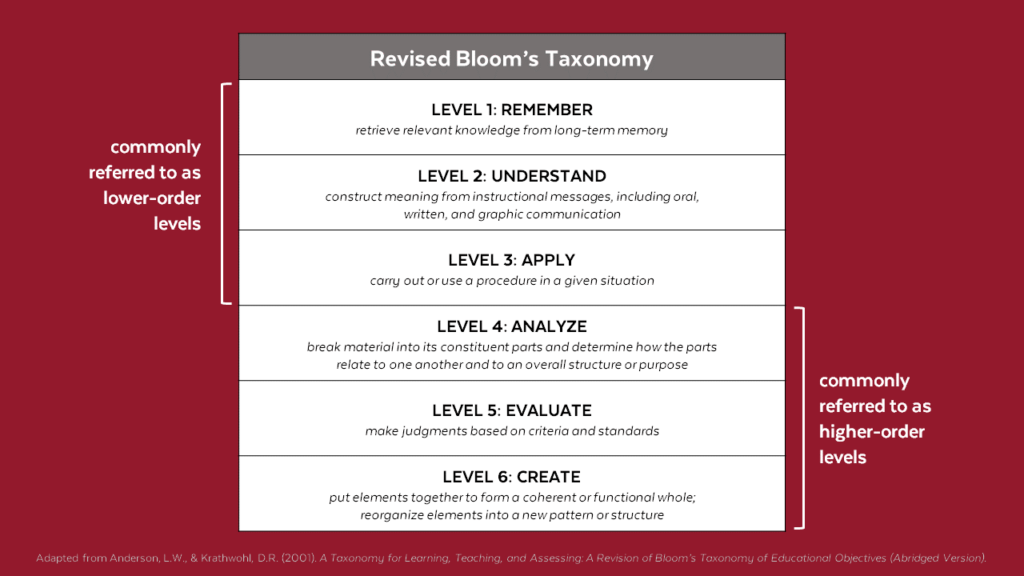
So if we just look at Bloom’s, which levels would be seen as representing “higher-order” thinking? Logically, it would seem that any task that goes above the Remember level—where students simply recall information—would be considered “higher” because it’s higher than that lowest level. But in many discussions of higher-order thinking, this label is often reserved for the three highest levels: Analyze, Evaluate, and Create.
So for now, when I say “higher order,” I’ll be referring to those three levels.
By the way, there is nothing inherently wrong with the lower levels; taking in information, understanding it, and applying it are all necessary and vital parts of a good education. But if our students work only at those levels day in and day out, they aren’t becoming good thinkers. Without regular opportunities to pull ideas apart, evaluate texts and situations, and use what they learn to develop new ideas, they aren’t going to be able to do much with the information they learn at the lower levels, especially once they’re out of school.
On top of that, a course that only asks students to receive information and spit it back out is really, really boring. If we want engaged students who actually care about what they’re learning, we have to ask them to do more than just regurgitate.
Two Common Mistakes
When teachers I have worked with plan learning experiences, and they want to include higher-order thinking activities, they most often tend to make two particular mistakes. Avoiding these two errors should go a long way toward making the “higher-order” label more accurate in all schools.
Mistake 1: Thinking a task is at the “Analyze” level when it’s really at the “Understand” level
Because we use the word “analyze” so often in conversation, its meaning has gotten slippery. Someone could say “analyze that painting,” and another person might answer by giving a basic description of the painting and offering an opinion about its meaning.
True analysis goes deeper, breaking a whole into parts and looking at how those parts impact the whole, differentiating relevant from irrelevant information, organizing ideas within a particular structure, or recognizing underlying bias, values or point of view.
“To truly analyze a painting, for example” says author and instructional coach Julie Stern, “we would require that students do one of the above, such as discussing how the use of colors, materials, or other artistic technique impact one another, or how they impact the overall meaning of the painting.”
For the analysis to be legitimate, Stern adds, we also have to be careful that the situation presented is one that we have not previously taught in class. “We have to be sure that students are not merely remembering and repeating our analysis of the painting, novel, war, etc., that we studied together in class.” Instead, students can demonstrate their analytical skills by analyzing a completely new painting.
Because we don’t always think of analysis with this tighter definition, we sometimes think certain tasks are at the “Analyze” level, when they are actually at the “Understand” level.
It’s not surprising that we make this mistake: The “Understand” level encompasses a surprising number of cognitive tasks that go well beyond simple recall of facts: Anderson & Krathwohl’s revised taxonomy includes interpreting, exemplifying, classifying, summarizing, inferring, comparing, and explaining within this level. Understand-level work can be rigorous and challenging; it should be a regular part of the work students do. But there are much higher levels of thinking that we can build into our classroom routines on a regular basis.
Mistake 2: Thinking a task is at the “Create” level when it’s actually a “Remember” or “Understand” task with a pretty package
Teachers assign all kinds of projects that they believe hit the Create level of Bloom’s: posters, dioramas, booklets, and so on. While it may appear on the surface that students are actively creating something new, in a lot of cases they are still working at a very low cognitive level, merely reassembling facts and delivering them in a pretty package.
Technology can make this problem worse: Students may be tasked with creating a video, a Prezi, or even a digital game, but if the content of the end product is little more than a rehashing of facts, that task is still at a lower level.
“Create, according to the Revised Bloom’s,” Stern explains, “requires students to organize elements into a pattern, structure, or product that is new, or has not previously existed. One way to think about it is that ‘analysis’ is breaking elements apart to discuss how the parts impact each other or the larger structure. And ‘creating’ is putting the elements back together in a new way or in a new situation.”
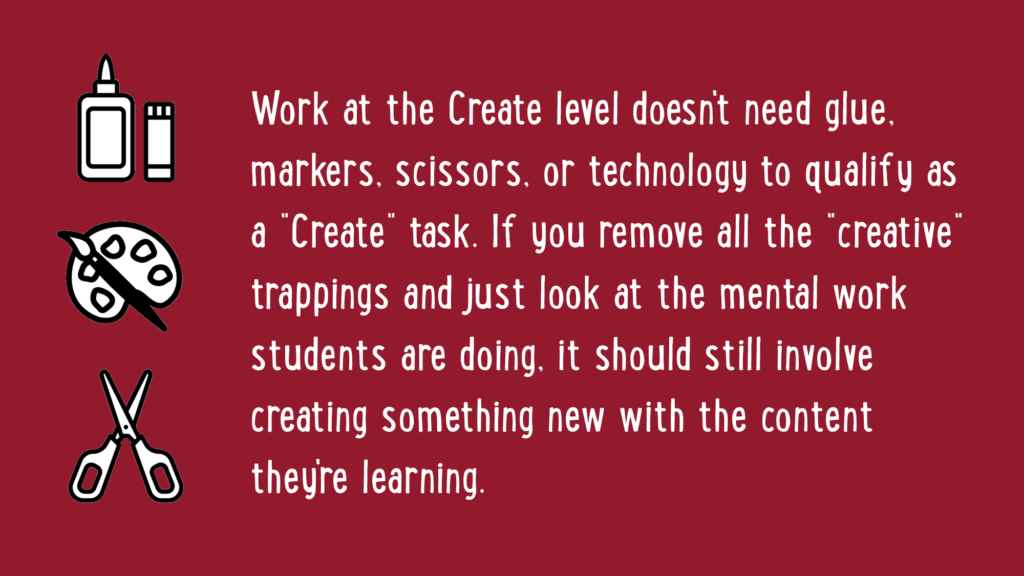
So when studying animal habitats, having students build a clay model of a habitat for an animal you studied in class might feel like a creative project, but in reality, students are just making a 3-D representation of facts they already learned.
“When we ask students to ‘create’ a poster, brochure, video, or digital game that creatively explains the main points discussed in class,” Stern says, “we are not reaching a higher level of thinking. Again, it might be helpful to think about a new context or situation, even a hypothetical one, not simply a new product. If we want students to create a habitat for an animal, it should be a different type of animal than ones we previously discussed.”
Here’s another way to look at it: Work at the Create level doesn’t really need glue, markers, scissors, or technology to qualify as a “Create” task. If you remove all the “creative” trappings and just look at the mental work students are doing, it should still involve creating something new with the content they’re learning.
Sample Lesson: Bill of Rights
Now let’s take a look at these mistakes within the context of a more complete set of lesson plans, followed by another set that does a better job of building in higher-order thinking.
Tony is an 8th grade social studies teacher who is designing a set of lessons on the Bill of Rights of the U.S. Constitution. His state standards say that students should be able to do the following in regards to the Bill of Rights:
- Identify and explain the rights granted to all citizens by the Bill of Rights
- Identify and evaluate contemporary issues that involve the rights granted by the Bill of Rights
We’ll start with Tony’s original lesson plans, the ones he’s used to teach the Bill of Rights for several years now. Then we’ll look at another set of plans from the Bill of Rights Institute that tackles the same basic goals, but pushes students to higher levels of thinking about the material.
Time frames are based on class periods of about 45-60 minutes.
Bill of Rights Lesson Plan: BEFORE
(Duration: 1 week)
1: Lecture & Handout (1 class period)
Tony gives a lecture with a PowerPoint that lists and explains all 10 amendments in the Bill of Rights. During the lecture, students complete a handout where they fill in blanks about the Bill of Rights. The information they add comes directly from the lecture: numbers, names, definitions, and examples of each of the 10 amendments.
This activity is at the Remember level of Bloom’s: Students are simply taking in the information and recording it.
2: Student Websites (3 ½ class periods)
Each student chooses one right from the Bill of Rights and creates a 4-page website about it, where they have to provide the original text of the amendment, define the right, add two pictures that show the right being exercised, and create a list of at least four links to articles that show the right either being violated or exercised.
Tony believes this activity is at the Create level, because students are creating their own websites, but because they’re just defining the amendment, giving examples, and linking to other examples without commentary, the work never rises above the Understand level. Unfortunately, because students are learning new technology in order to do this project, it takes most of the week to complete, which makes it a strong candidate for the Grecian Urn label: a task that consumes far more time than it gives back in terms of learning.
3: Test (½ class period)
The test asks students to correctly identify the number of each amendment, then match the amendment with descriptions of people exercising their rights. The final extended response question asks students to give three examples from their daily lives where they exercise one of the rights guaranteed by the Bill of Rights, and discuss why each right is important to them.
While most of this test is at the Remember level, Tony believes the final question is at the Analyze level, because students are “analyzing” the relationship between the Bill of Rights and their own lives. In fact, they are really just giving examples of the rights in their own lives, and exemplifying is at the Understand level.
Bill of Rights Lesson Plan: AFTER
(Duration: 1 week)
This revised version contains more higher-order thinking. It comes from the Bill of Rights lesson plan offered free as part of the Being an American series offered by the Bill of Rights Institute. Although the original plan says it’s for a single day, it relies heavily on homework to make that happen. Moving the homework activities into class time would make this about a 1-week set of lessons.
1: Rephrasing the Bill of Rights (½ class period)
Students receive a copy of the Bill of Rights and translate each amendment into their own contemporary language.
This task is at the Understand level, because students are interpreting the rights into their own language. Again, some lower-level thinking is going to be a part of any learning cycle, so this set of plans will also include some activities in the lower levels. With that said, work at the Understand level is still more cognitively complex than the Remember level: This activity does push students to do more than simply copy down the information.
2: The Value of Rights Handout (½ class period)
Students choose the five rights they think are most important and rank them from most to least important, then answer a few questions about why they made these choices. A class discussion follows, where students are asked to consider whether other factors (age, family situation) would change their answers if they were different from their current life.
This is at the Evaluate level, because students are making judgments about the relative importance of the amendments.
3: Scenario Cards (1 class period)
Students work in groups to read cards that describe various scenarios and identify which right is being violated in each one and which amendment offers protection for that right.
This activity is at the Understand level, because students are being asked to classify each scenario as an example of a specific right.
4: The Bill of Rights Today (1 class period)
Students must locate five current news stories related to the Bill of Rights. For each one, they will need to summarize the story, identify which amendment is related to the story, and discuss how the issue might touch their own lives.
Although this activity is similar to the one before it, having students classify stories by the most relevant amendment, this task is a bit more complex because the scenarios here are not pre-screened for them: Students will have to find their own articles and dig through irrelevant details to determine which amendment is most clearly illustrated in the articles. That kind of work takes this activity closer to the Analysis level.
5: “Life Without…” Stories (1-2 class periods)
After reading a short story, “Life Without Rights for the Accused,” which illustrates life in a society where government does not honor the criminal procedure protections in the Bill of Rights, students write their own stories about what life would be like if citizens didn’t have one particular right.
This is at the Create level. Students are using their knowledge of our current rights and how they play out in everyday life to imagine a different society where those rights are not present.
Even though both sets of plans take about the same amount of time to teach, the “After” set gives students many more opportunities to engage deeply with the content, and students in that classroom are more likely to finish the week with an enduring, transferable understanding of their constitutional rights. If you were walking past both classrooms, it might look like the kids making their own websites are doing more engaging, 21st-century work, but cognitively, those websites don’t demand much from students at all.
Beyond the Levels, Beyond the Verbs
When we are striving to develop deeper, more rigorous learning experiences for our students, it’s easy to get bogged down in trying to figure out exactly which level a task fits into or which verb is the most accurate. If you find yourself spending way too long on the labeling aspect of planning, it’s time to stop and refocus on a different question…
What do I want students to be able to do with this knowledge once the lesson is over?
In other words, why are they learning this stuff, how do I want them to transfer that learning to real life, and how can I replicate those uses in a classroom activity?
Let’s consider the Bill of Rights. We want our citizens to understand their rights so that when their rights or the rights of people they know are violated, they’ll recognize it and be able to take action. This is one of the ways we participate in a democratic society, right? So an activity where students look at sample situations and identify which rights are being infringed upon is one way to have them transfer their knowledge of the Bill of Rights into new situations, cases that might be similar to things they may experience themselves. Finding more articles from current publications can extend that learning even further.
And what about the Create task in the “After” lesson? What is the value of having students write a story about life without one of the freedoms granted by the Bill of Rights? This kind of activity deepens their understanding of their rights. Rather than simply recopying the same information into a new package, they are being asked to actively imagine a different life from the one they’re living, with one significant right removed from it. That kind of exercise gets them to think more about how these rights actually impact their day-to-day lives, which is a far more complex task than recalling the list of rights from what they were taught.
The “After” lesson presented here is just one example of how to build more higher-order thinking into students’ learning experiences. It can be done in lots of ways, and the goal isn’t to always hit every level; instead, choose activities that will get students working with the material in ways that will serve them later in life.
The next time Ms. Jackson teaches figurative language, she can skip the wire hangers and just have students use figurative language in their own personal narratives, poems, or essays. The writing won’t necessarily make the classroom any prettier, but for the rest of their lives, those kids may be more likely to use better metaphors, personification, and alliteration to make their writing more powerful: college essays, professional presentations, even love letters.
Which is kind of the point, isn’t it? ♦
Join our mailing list and get weekly tips, tools, and inspiration that will make your teaching more effective and fun. You’ll get access to our members-only library of free downloads, including 20 Ways to Cut Your Grading Time in Half, the e-booklet that has helped thousands of teachers save time on grading. Over 50,000 teachers have already joined—come on in.

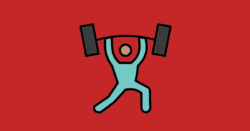
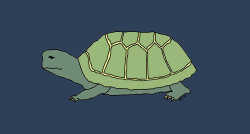
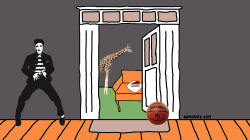
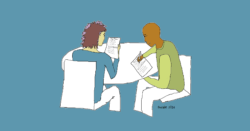
I’m having trouble with the distinction shown here between “exemplifying” and “analyzing. ” In each of the examples given students are to determine whether a situation fits a standard. That’s analysis as I understand it. Whether the examples are given or they find them on their own the process is the same (Does this exemplify or violate one of the rights? If so, which one? Does it violate or exemplify? In what way does it meet the standard?) This is certainly higher order or deep level thinking. More to your point this is a way in which they will be applying the rights for the rest of their lives.
Hey Herb,
Thanks for sharing – this is exactly why Jenn wrote this post! When students are asked to share examples of a concept, whether their own or from things they find, they really aren’t doing much more than identifying or recognizing situations that reflect their understanding. For example, students can open a book and find a bunch of examples of proper nouns to show they understand this part of speech. However, to gain deeper understanding of how writers intentionally use proper nouns to choose character names, ask students to find a book whose characters’ names impact the story. This requires them to analyze character actions, dialogue and story events. This is a pretty simplified example, but hope it helps. And yes, any time we’re asking kids to do more than regurgitate back to us what they learned, we’re moving them toward more critical thinking.
Thanks for this wonderful post. I love it when we educators show examples of instructional redesign. We need much, much more of this.
FYI, this is why we created the 4 Shifts Protocol, bit.ly/4shifts: to help educators redesign lessons and units for deeper learning, greater student agency, more authentic work, and rich technology infusion. The protocol is free and open source and has been taking off pretty quickly in schools all across the world. I’m also happy to send a book to you, Jennifer. Just get in touch. 🙂
Thanks for all that you do to raise the level of cognitive complexity and student voice and choice. All my best.
SCOTT
Hello! Could I get a copy of that book?
“The final extended response question asks students to give three examples from their daily lives where they exercise one of the rights”– that’s application.
Hi Penny,
Thanks for taking the time to share. Generally, when we ask students to give examples, we’re really just asking them to show they understand what the concept means. However, if they are tasked to take what they learned and use it in a new situation, then we’ve moved them to that application level. Right now, I’m not seeing how giving 3 examples requires them to use the concept in a new way, but since these levels can get confusing or overlap, I’m curious to hear more. Thanks!
A little late to your blog, but the way I understand this is by not only thinking about the Bloom’s verb but also the direct object which I supply. So if I ask my students to create a mobile about figurative language, the are doing high order thinking about mobiles, but not necessarily about figurative language. If I ask them to create a simile, for example, they are doing high order thinking about figurative language. I think we are seeing the same thing but in different ways.
Absolutely love the instructional redesign and think this is a wonderful explanation of an essential topic in education.
I was wondering about ways to make sure the redesigned project (the short story) meets the “create” level. If students regurgitate similar scenarios to the example story or scenario cards within the creative varnish of a short story I’m not sure that, that is all to disimilar from the exemplifying an understanding, or worse paraphrasing remembered scenarios or events in the exemplar story.
I’m a middle school social studies teacher and will likely use this as a basic outline for next year but I am a bit worried. There are also assumed skills that need to be accounted for like researching online and crafting a story.
None of these potential drawbacks are too disheartening, but if anyone has feedback please let me know. It will be a while before I teach this topic again so feel free to comment anytime.
This was an excellent article, thank you so much! I appreciated the breakdown of Bloom’s taxonomy and how to better implement higher order thinking tasks in the classroom.
Sometimes it seems that these labels get thrown around without careful attention to detail like education buzzwords. The analysis (or explication?) of common teacher mistakes made a lot of sense and was very helpful for my understanding. I particularly enjoyed seeing the comparative lesson plan exemplars which made the differences clear and meaningful.
Re the figurative language project, while the mobiles sound like lovely aesthetic additions to classroom decor, and also good reminders for different types of devices we can use in our writing, I agree that the project doesn’t quite rise to the level of “create” for the students in the way it was originally intended. I can recall a fun assignment our teacher had us do in 5th grade that related to fig lang. We selected an idiom from the English language and created a visual illustration of it. I did “elbow grease” by drawing a simple advert image of a paint can filled with purple goop and a label showing a strong arm. 💪I think this may be an example of “create” because the students have to translate their understanding to a visual language (not just verbal/symbolic words) and come up with a creative way to share it by making an abstract concept into a literal example.
Love this blog and look forward to reading more soon!
This is amazing, thank you for the insight! I have to admit I’m new to Bloom’s taxonomy etc -but I always thought that should be turned upside down!
Thank you for sharing before and after examples, very helpful!
I love these types of articles that not only shed light on important topics, but also provide a “before and after” view of what improvements can look like. I often see these types of lesson examples for Humanities and science topics, do you have any resources for high school math classes/competencies that you could recommend that specifically address higher-order thinking skills (beyond packaged word problems)?
Hi Barb! Glad you liked the post. Take a look at To Boost Higher-Order Thinking, Try Curation. I’ve seen this work really well with math. We also have a lot of resources on our Math Pinterest board – you may find some relevant things over there.
This was great insight to Bloom’s and I will use the information to keep my students engaged in ELA activities. I will definitely checkout the website listed for more ideas.
I’m struggling with the question of “Why are [students] learning this stuff, how do I want them to transfer that learning to real life, and how can I replicate those uses in a classroom activity?” in the context of reading literature. (For context, I’m a middle school ELA student teacher.)
Students aren’t going to need to read stories in the real world unless they become a teacher or writer, and I know telling them they need to learn to analyze literature in order to do well in school isn’t enough of a reason to convince a lot of students of the relevance and importance of literature to their lives. How do I go about convincing them that “[citing] textual evidence to support analysis of what the text says explicitly as well as inferences drawn from the text” (i.e., RL6.1) is relevant and important to their lives, for instance?
Hey Brooke,
I think this is a pretty common question that a lot of teachers tend to struggle with – why are we teaching this “thing” other than for the fact that it’s a required standard? Before we can expect kids to find value in what we’re asking them to do, before we teach a lesson that takes up valuable instructional time, we need to figure that out for ourselves.
Outside of the classroom, we’re surrounded by stories – stories we hear from friends, on the news, in a podcast, and stories we read on social media, websites, and in magazines, newspapers, and books. The standard you referenced really applies to any kind of literature. Analyzing, interpreting, and justifying are the things that critical readers, thinkers and problem solvers do. Thinking critically impacts just about every aspect of our lives. Since this is a really big topic, which is hard to cover in a reply here, if you haven’t already, my suggestion is to check out the following resources. I hope you find them helpful!
Does Your School Need a Literacy Check-Up
Deeper Class Discussions with the TQE Method
How To Stop Killing the Love of Reading
Up-Down-Both-Why: A Feeling-Based Approach to Literature
Hexagonal Thinking: A Colorful Tool for Discussion
A Simple Trick for Success with One-Pagers
Thanks Debbie, this is very helpful!
Worth reading and indeed apt.
It’s very useful.
How clearly explained the create level of blooms taxonomy.
Thanks
Hi Jenn,
Your statement, “why are they learning this stuff, how do I want them to transfer that learning to real life, and how can I replicate those uses in a classroom activity?” really exemplifies the importance of backwards planning/mapping. We need to start at the end and ask ourselves what should my students walk away from this lesson knowing about/how to do. Then we work backwards to determine how we get them to that point (lessons/activities) and how we will know (assessment).
I too find it difficult at times to determine which level my activity or assessment is really at (understanding vs analyzing vs creating). Your explanations and examples really helped make that more clear.
Thanks!
Jenn will be glad to know the post was helpful for you, Tai!
This was a great article addressing a question that many teachers and even students ask with higher order thinking skills being a dominant part of today’s education system. The comparison of before and after in the lesson plan was also a great way to provide a clear understanding of what higher order tasks should really be. All in all it is a great article in a blog that is a truly useful resource for teachers.
Jenn will be glad to know that you found it helpful, Roshini. Thanks for sharing!
thanks for all the useful information
We’re glad you enjoyed the article!